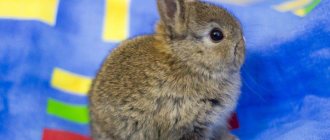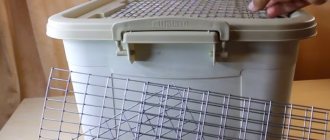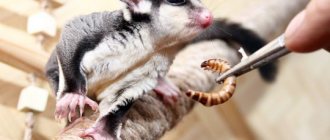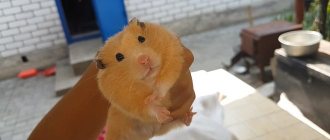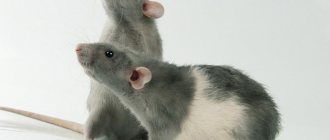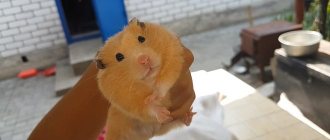Recently, it has become fashionable to have unusual pets. One of these is the domestic rabbit, caring for which will not be difficult. He is able to please his owners with his appearance and mobility. When planning to get this animal, find out more information about it.
Basic requirements for keeping rabbits
Keeping a rabbit at home requires the future owner to take a serious approach and have some knowledge about caring for the animal. This animal is very vulnerable and does not tolerate:
- dampness;
- dirt;
- draft;
- temperature changes;
- extreme heat;
- stressful situations.
All these factors can negatively affect the health of the rodent and even shorten its life. Anyone who wants to have a decorative rabbit at home first needs to learn more about its characteristics.
There are strict requirements for keeping and caring for a pet:
- The room temperature should vary from +18 to +25 degrees. If the thermometer readings are high, your pet is at risk of overheating. Some individuals die from hyperthermia. Sharp fluctuations in the mercury column are unacceptable.
- Humidity – 50-60%. Too dry and very humid air is equally harmful to the health of a decorative rabbit. In such conditions the rodent will get sick.
- Good ventilation is important when caring for an animal. The room should be ventilated, but it is important to ensure that the pet is not in a draft. This can lead to a cold.
- Calm environment. Decorative rabbits are very timid, some die from stress. If there are small children in the house, you need to explain to them how to properly handle the animal - you cannot make noise, grab it or press it too hard.
- Purity. Cage care is very important. It is necessary to change the litter at least once a week. In sawdust that is wet and dirty from urine and droppings, microbes multiply and can cause various diseases in your pet.
Important! Heat exchange in rabbits occurs through the skin of the ears. When a rodent is very hot, the ears become hot. To cool your pet, you should wipe them with a damp cloth.
Is it possible to grab it by the withers?
If you look at the photo below, you will see that it is also not recommended to take an animal by a fold of skin on the neck or back. This is not as dangerous as in the case of the ears, but there are other, safer ways.
The fact that this method is more comfortable for the animal is evidenced by the fact that, as a rule, in this situation it does not break out or scratch. Most often, the crawl simply hangs down, while its neck and head are pulled back somewhat.If you use this method of lifting, then you must support the crawl’s body in the sacrum area with your second hand.
By the way, it is by the withers that the rabbits are carried by their parents. Some rabbit breeders advise holding animals with both hands at the same time: one in the neck area, the other in the back area. This way it will be in a horizontal position, and the body weight will be evenly distributed.
Cage selection and equipment
Before purchasing a decorative rabbit, you should take care to create favorable conditions for its maintenance. You need to buy a comfortable cage and equipment. The rodent will spend most of its time in its home, so it should be comfortable.
It is also important to find a suitable place in the apartment to place the pet. This could be a hall, a living room, or a distant, quiet room.
It is better to place the home of a decorative rabbit on a cabinet or table in the back of the room so that it is not exposed to direct sunlight from the window.
Important! A rodent's cage cannot be located near a heating radiator - it is too hot there in winter.
Dimensions of the home
Decorative rabbits are kept in cages. When choosing a home for a rodent, the breed of the rodent is taken into account. There are many breeds for home keeping and, as a rule, these are medium-sized animals whose weight ranges from 1.5 to 2.5 kg.
True, there are mini rabbits - these are tiny rodents weighing from 600 g to 1.4 kg.
Attention! Before you buy a cage to keep a rabbit, it is important to decide what breed you plan to have.
For small decorative rabbits, whose weight does not exceed 1.5 kg, a dwelling with dimensions of 0.8 x 0.6 m is suitable. To keep larger rodents, you should buy a larger cage - 1 m long and at least 0.6 m wide. The height of the structure should allow the pet to stand on its hind legs, which is approximately 60 cm.
If you plan to breed decorative rabbits, you will need 2 cages. One is for keeping the male, the other is for the female. You can purchase a two-section design, the parts of which are separated by a partition.
The main thing is that each pet has enough free space inside. To keep the rabbits after leaving the mother, you will need a separate home.
Design requirements
A cage for a decorative rabbit should be comfortable both for its future inhabitant and for the owner of the rodent. It is important that it is easy to care for. It’s good if the product is equipped with a retractable plastic tray, it is easy to clean and remove droppings. The cage should be made of either wood and metal or galvanized mesh and be equipped with a securely closing door.
Important! When purchasing a home for keeping a decorative rabbit, it is important to make sure that there are no sharp elements inside that could injure the animal.
Inventory
A decorative rabbit will need 2 feeders - one for dry food, the other for succulent food. You also need to buy a sennik - a box for dry grass. Hay should not lie on the floor along with rodent excrement. Still need a drinking bowl. It is better to give preference to automatic or nipple. It is attached to the outside of the cage, and the spout that supplies water goes inside through the grate. This type of drinker cannot be knocked over. In addition, the water in it remains clean longer, does not bloom, and caring for such a container is very simple.
Another important attribute of a decorative rabbit’s home is a house. It is necessary for the pet to hide there when it is afraid of something. This is a kind of shelter where the animal can rest and recover from stress.
The house will serve as a nest for a rabbit who is going to become a mother. It is selected taking into account the size of the animal. The pet should be comfortable lying and turning around inside.
A tray for a decorative rabbit is installed in the apartment. It is quite bulky, so it is unlikely to fit in the cage. It is difficult to train a pet to go to the toilet in a specially designated place, but many succeed. Decorative rabbits go into a tray with litter when they are let out to walk around the house.
When they are in their home, they relieve themselves right on the floor. Therefore, it is advisable to pour filler - straw or wood shavings - onto the bottom of the cage.
A place in the house for a fluffy
Eared pets should be provided with the following important conditions:
- sufficient light;
- warm;
- dryness;
- good ventilation;
- no drafts.
To provide these conditions, it is necessary to choose the right location for the rabbit house. It should be placed in a bright place, but away from direct sunlight - at high temperatures, rabbits can experience heat strokes. Daylight hours should last approximately 17 hours.
The corner where the cage will stand should be warm, but not hot.
There should be no heating devices or radiators nearby. A comfortable temperature for rabbits is considered to be 12–18 degrees. They can withstand short-term drops in the thermometer down to -6 °C and increases up to +35 °C. In order for there to be good air exchange in the place where the rabbit lives, short-term ventilation is necessary in winter, and a slight draft is allowed in summer.
Hygiene and care
Caring for rabbits at home is not very difficult, but this matter has its own nuances. A novice rabbit breeder may not know how important it is to maintain order in a rodent’s home. With poor quality care and irregular cleaning of the cage, the litter becomes contaminated with urine and feces. This leads to the formation of mold. Ammonia is released from the decomposing droppings, and the rabbit is forced to breathe toxic fumes. All this can lead to a decrease in the pet’s immunity and illness.
One of the most important aspects of caring for a decorative rabbit is maintaining cleanliness inside its home. The litter is changed every 5-7 days. During cleaning, the rodent is removed and the equipment is washed with hot water. The same is done with the pallet. The drinking bowl and feeder are scalded with boiling water.
The owner of a decorative rabbit, who wants to provide him with good living conditions and quality care, must carry out disinfection once a month. In this case, all parts of the cell are treated with special solutions to destroy microbes.
Grooming
It is important to maintain the beauty of the animal's fur. This is another important aspect of caring for a decorative rabbit. In representatives of long-haired breeds, the coat gets tangled and eventually becomes tangled.
Caring for the cover involves regular brushing. For this, a special comb is used, which helps remove lost hairs. The procedure is carried out 2 times a week. It is advisable to comb rabbits with long and thick fur every other day.
Attention! Rodents do not regurgitate fur like cats do. Ingested fur can cause intestinal blockage and tympany.
Rabbits are clean animals. They groom their fur using their tongue. But if the animal gets very dirty, it will have to be washed. Veterinarians do not recommend bathing rodents in water - it is very stressful for them. In addition, your pet may catch a cold.
It is best to wash the rabbit partially - wet and wipe with a rag only heavily soiled areas of the body - the fur on the cheeks and neck, near the anus, as well as the paws.
Nail care
Those who have decided to keep a decorative rabbit need to know how to properly care for their pet’s claws. The fact is that they gradually grow back and then begin to curl. This not only causes discomfort to the animal, but also poses a danger to its health. Deformed claws injure the paw pads and can even lead to musculoskeletal disorders.
Nail care involves regularly trimming overgrown tips. The procedure is carried out approximately once a month. To do this you will need a special tool. There are small nippers on sale with an oval guillotine-shaped hole - a very convenient thing for caring for animal claws. The end of the claw, about 1 mm long, is inserted into the slot of the nippers and carefully cut off.
Dental care
If the rabbit's diet is prepared correctly and contains enough solid food, then the rodent's teeth do not need care. In this case, they grind off on their own. However, pets often have problems with their incisors - they do not have time to wear off naturally, so they grow too long.
This leads to undesirable consequences:
- a decorative rabbit cannot eat or chew food normally;
- weight loss occurs;
- The mucous membrane of the lips is injured, stomatitis develops.
Rabbits that are kept at home often have to have their teeth trimmed to avoid such problems. The procedure is carried out in a veterinary clinic. To prevent excessive growth of incisors, you need to introduce not only hay, but also twig food into the menu of your decorative rabbit.
Popular breeds
Today, about two hundred decorative breeds of rabbits have been bred. They mainly differ in the following characteristics:
- By weight and size: large, medium and miniature.
- By coat length: with medium coat length, long-haired, short-haired and mixed, i.e., individual areas of the body have fur of different lengths.
- By color: one-color, two-color, three-color. More than 60 types of colors are known.
- According to the fit and shape of the ears. Ears can be short, long, wide. They may stick up or hang down the sides of the head.
The main criteria for popular breeds can be found in the table.
| Breed name | Weight, kg | How long do they live, years | Wool length | Ears, cm | Color | Character |
| Dutch dwarf | 1,7 | 7 | average | 5-7.5 erect | plain: grey, black, blue or tortoiseshell | active, mobile |
| Dutch Fold | 1,7 | 7 | average | 25 hanging | plain, two-color | friendly, affectionate, easy to train |
| Dwarf ram | 2 | 6-7 | short | 28 hanging | plain, two-color | calm, good-natured |
| Dwarf butterfly | 1,8 | 7 | short | 8 erect | black and white | calm, friendly |
| Rex | 1,7 | 6 | short | 7 erect | plain, two-color | calm |
| Hermelin | 1,5 | 8-12 | short | 5 erect | white | sociable, active, affectionate |
| Angora dwarf | 1,7 | 5-7 | long | 4-5 erect | plain: white, red, gray, two-color: gray with white, red with gray | sociable, calm |
| Angora lion | 1,6 | 9 | long | 5-6 erect | white, brown, red | sociable, affectionate |
| Lion head | 1,7 | 7 | short on the body, long on the head | 8-9 erect | blue, opal, chinchilla, sable | timid, active |
Feeding
Keeping a decorative rabbit requires the owner to know what to feed the eared pet. A properly formulated diet will help maintain the rodent’s immunity.
Basic feeding recommendations:
- feeders should be filled 2 times a day - morning and evening;
- the daily amount of feed for an adult rodent is 2-3 tablespoons;
- Before serving fresh grass, you must make sure that there are no poisonous plants among them;
- Fruits and vegetables should be offered chopped (in small pieces).
The rabbit's diet is based on roughage, the share of which reaches 60% of all food received. These are dry grain mixtures and hay. Pet stores sell feed for decorative rabbits. It contains oats, barley, beans and grass pellets. The composition of such food is correctly balanced, so that the pet receives all the substances necessary for health.
In addition to rough food, rodents need greens and vegetables. This food is called juicy. Decorative rabbits adore the stems and leaves of nettle, dandelion, plantain, as well as alfalfa, burdock and thistle. Among the vegetables, you can give the animal carrots, Jerusalem artichoke, cabbage, cucumbers, and pumpkin. Long-eared pets willingly eat apples and berries. In winter, it is advisable to introduce wheat sprouts into the animal’s diet; they contain a lot of vitamins.
Important! It is better to collect wild herbs for feeding rodents away from highways and industrial enterprises.
It is important for those who care for a decorative rabbit to know that mineral supplements must be present in its diet. This is bone meal, chalk, and salt in small quantities. Violation of the rules for keeping and feeding a rodent will lead to a decrease in immunity and the rapid death of the pet.
When caring for an animal, it is important to ensure that food does not stagnate or rot in the feeder.
Eating spoiled food is one of the reasons why rabbits kept at home die.
Disease Prevention
It is impossible to provide good care for a decorative rabbit if you do not protect it from deadly diseases. These include:
- pasteurellosis;
- coccidiosis;
- myxomatosis;
- viral hemorrhagic disease.
Before handing over a baby rabbit to new owners, breeders must vaccinate it. The first vaccination is carried out at the age of 40-45 days, then according to the schedule.
Caring for a rabbit also includes deworming. Even if your pet does not have an outdoor run, there is still a risk of infection with worms and protozoa. For this reason, veterinarians recommend feeding the animal with anthelmintic drugs 1-2 times a year for prevention.
Health
Rabbits by nature have poor immunity and often get sick. Animals tolerate infectious diseases the worst.
One of the most dangerous diseases is myxomatosis. The disease is incurable; it can only be prevented through preventive vaccination. If a rabbit gets sick and the vaccine has not been given, it must be immediately euthanized and the body burned. Symptoms of myxomatosis are swollen eyelids, ears, genitals, conjunctivitis. Bald patches and sores may occur in the affected areas of the skin.
Another dangerous disease is coccidiosis. The disease poses the main threat to small rabbits up to 3 months old. Symptoms: bloating, poor appetite. Choosing quality food and clean drinking water will help protect against disease.
Rabbits live for about five to seven years, but in the right living conditions the animal can live up to 12 years.
Education and games
When a baby rabbit is adopted by a family, its owners have a lot of work to do. The animal needs to be tamed and educated. The process of accustoming to hands proceeds in different ways - some rodents learn quickly, others slowly. Regular contact with your pet is no less important than good care. Household members should be patient and spend at least 30 minutes with the rabbit every day. When the animal gets used to their smell and understands that it is not in danger, it will willingly go into your arms.
Keeping a decorative rabbit at home is not limited to just caring for it. The animal needs active games. The animal cannot be in a cage all the time, otherwise it will gain excess weight. Sometimes he needs to be let out to run around the apartment, but only under the supervision of the owner. There are many dangers in the house, for example, wires, indoor plants, some of which are poisonous. The rabbit should not be allowed to approach them.
The pet should have different toys at its disposal - a ball, rattles, cardboard cones, even an ordinary linen rag can be used for entertainment. If your rabbit likes to dig, you can buy a large plastic container, fill it with paper and put the animal inside.
Animal protection
When purchasing a rabbit, you also need to consider its protection. The animal is partial to everything that can be chewed. He will definitely appreciate your new sofa, carpet, bedspread or electrical wires. When the animal walks around the apartment, all these dangerous elements must be hidden so that the rabbit does not have access to them. Tree branches or special toys will help solve the problem. Young rabbits require special attention; their need and desire to chew on everything is much stronger than that of an adult animal.
Walks
Home-kept decorative rabbits often suffer from vitamin D deficiency because they do not go outside. Walking in the fresh air is good for health, but only in dry, windless weather and in a secluded place.
It’s good if the owner of the animal has a dacha with a green yard, where you can install a spacious enclosure for your long-eared pet. The main thing is that it is partially in the shade of trees.
There is nowhere to walk a decorative rabbit in the city, except perhaps in park areas. However, in such places there is a high probability of stumbling upon the excrement of stray dogs and cats. The courtyards of high-rise buildings are too noisy - a timid rabbit is unlikely to enjoy a walk in such conditions. If there is a quiet place with a green lawn near your house, you can take your pet for a walk on a harness. But in this case, we cannot exclude the risk of infection with skin parasites - fleas and ticks, and helminths.
Who to choose: female or male
Rabbits can be kept alone. It is believed that females behave more calmly and reservedly, while males are sociable and playful. However, this is not quite true. Sociability, friendliness and affection are formed not by gender, but by innate temperament and upbringing. Both females and males can be both gentle and aggressive in response to a certain attitude towards them. They can also show aggression during puberty. Both males and females mark their territory.
If you plan to keep several individuals, then you need to choose a pair of different sexes, but take into account the fact that in this case, upon reaching puberty, they will begin to breed. If this is not in the plans, then the boy will have to be castrated upon reaching 6 months of age.
2 females also get along well. But the boys will not be able to get along peacefully. Having reached adulthood, they will begin to divide the territory, which will not happen without fights, which means wounds and torn out pieces of fur.
The sex of rabbits is determined by their genitals. In females, next to the anus there is a genital slit in the form of a pink loop. In males, the genital organ is located further from the anus. It looks like a curved process.
Important! A decorative rabbit must be purchased at 2
–
2.5 months of age from a trusted breeder or in a pet store, making sure that its exterior meets the standards and health.
FAQ
Those who plan to adopt and care for a long-eared animal should know everything about rabbits. Below are questions that interest beginning rabbit breeders:
- What is the lifespan of an animal? On average, decorative rabbits live 9-12 years, but much depends on the conditions of detention and the quality of care.
- Why did the animal begin to show aggression? Some individuals change their character after puberty. Castration will help solve the problem.
- Is it worth raising rabbits at home? This is not an easy task - keeping an entire family of rodents involves large financial and time costs. In addition, female rabbits often abandon their offspring, then caring for the cubs falls entirely on the shoulders of the owner.
- Is it true that rabbits eat their own droppings? Yes, but they only eat caecotrophs - morning soft feces, which contain many useful substances. This phenomenon is called coprophagy.
- Why do rabbits eat all the time? In these animals, digestion is designed in such a way that food moves through the intestines due to the arrival of a new portion. Therefore, it is important that your pet always has access to food and water.
There are many nuances in keeping and caring for decorative rabbits that you should learn about in advance. The health and well-being of your pet depends on this.
